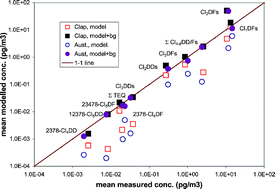Different approaches are used to verify the adequacy of emission factors (EFs) and their use in emission inventories of persistent organic pollutants (POPs). The applicability of EFs was tested using atmospheric dispersion modelling to predict atmospheric concentrations of polycyclic aromatic hydrocarbons (PAHs), polychlorinated biphenyls (PCBs), dibenzo-p-dioxins (PCDDs) and dibenzofurans (PCDFs) and resulting toxic equivalents (ΣTEQ) and particulate matter <10 μm (PM10) in two rural locations in northern England (UK). The modelling was based on general assumptions of fuel composition, consumption and heating needs to simulate emissions of POPs from the domestic burning of coal and wood where ambient measurements were made in the winter of 1998. The model was used to derive the local contribution to ambient air concentrations, which were estimated independently based on comparative air measurements. The results support the hypothesis that in both villages, the majority of PAHs and the lower chlorinated PCDFs were locally released. The situation for PCBs and polychlorinated naphthalenes (PCNs) was different. While the EFs show the release of both compound groups from the domestic burning of coal and wood, the ambient levels of these “legacy POPs” in the villages were still clearly dominated by other sources. Rural areas relying mainly on fossil fuels can exceed the proposed UK ambient air quality standard for benzo[a]pyrene during winter. The measured EFs were then used to estimate the importance of the domestic burning of coal and wood to national emission inventories for these compound classes. Extrapolations to the UK suggest that the domestic burning of pure wood and coal were minor emitters for chlorinated POPs but contributed strongly to PAH and PM10 levels in 2000. Finally, the UK’s national POPs emission inventories based on source inventories and EF, as used here, were compared to estimates derived using the increase in atmospheric concentration of selected POPs.

You have access to this article
 Please wait while we load your content...
Something went wrong. Try again?
Please wait while we load your content...
Something went wrong. Try again?


 Please wait while we load your content...
Please wait while we load your content...